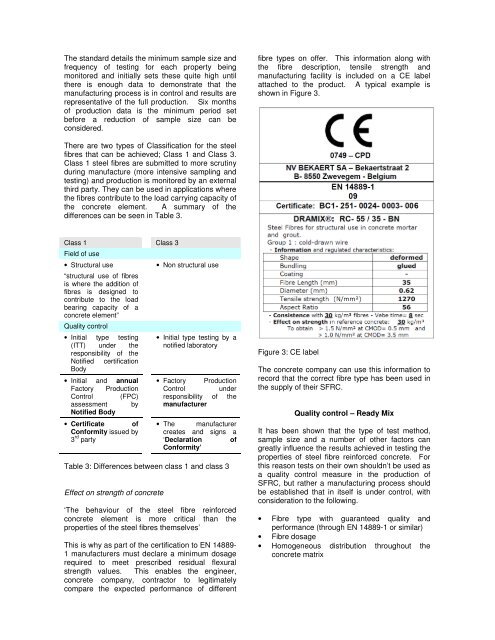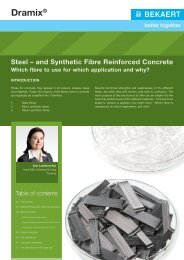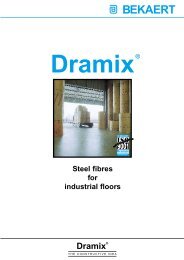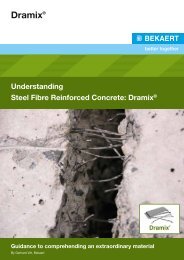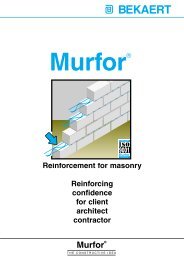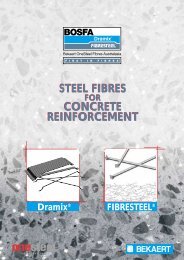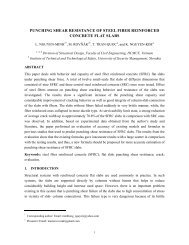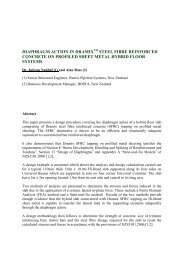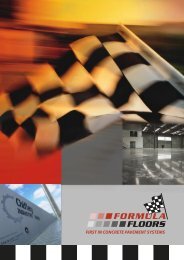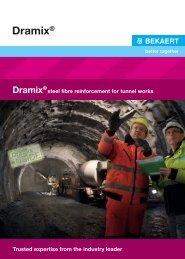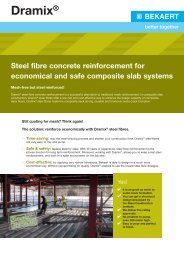Steel fibre reinforced concrete (SFRC) – Quality ... - BOSFA
Steel fibre reinforced concrete (SFRC) – Quality ... - BOSFA
Steel fibre reinforced concrete (SFRC) – Quality ... - BOSFA
You also want an ePaper? Increase the reach of your titles
YUMPU automatically turns print PDFs into web optimized ePapers that Google loves.
The standard details the minimum sample size and<br />
frequency of testing for each property being<br />
monitored and initially sets these quite high until<br />
there is enough data to demonstrate that the<br />
manufacturing process is in control and results are<br />
representative of the full production. Six months<br />
of production data is the minimum period set<br />
before a reduction of sample size can be<br />
considered.<br />
There are two types of Classification for the steel<br />
<strong>fibre</strong>s that can be achieved; Class 1 and Class 3.<br />
Class 1 steel <strong>fibre</strong>s are submitted to more scrutiny<br />
during manufacture (more intensive sampling and<br />
testing) and production is monitored by an external<br />
third party. They can be used in applications where<br />
the <strong>fibre</strong>s contribute to the load carrying capacity of<br />
the <strong>concrete</strong> element. A summary of the<br />
differences can be seen in Table 3.<br />
Class 1 Class 3<br />
Field of use<br />
• Structural use • Non structural use<br />
“structural use of <strong>fibre</strong>s<br />
is where the addition of<br />
<strong>fibre</strong>s is designed to<br />
contribute to the load<br />
bearing capacity of a<br />
<strong>concrete</strong> element”<br />
<strong>Quality</strong> control<br />
• Initial type testing<br />
(ITT) under the<br />
responsibility of the<br />
Notified certification<br />
Body<br />
• Initial and annual<br />
Factory Production<br />
Control (FPC)<br />
assessment by<br />
Notified Body<br />
• Certificate of<br />
Conformity issued by<br />
3 rd party<br />
• Initial type testing by a<br />
notified laboratory<br />
• Factory Production<br />
Control under<br />
responsibility of the<br />
manufacturer<br />
• The manufacturer<br />
creates and signs a<br />
‘Declaration of<br />
Conformity’<br />
Table 3: Differences between class 1 and class 3<br />
Effect on strength of <strong>concrete</strong><br />
‘The behaviour of the steel <strong>fibre</strong> <strong>reinforced</strong><br />
<strong>concrete</strong> element is more critical than the<br />
properties of the steel <strong>fibre</strong>s themselves’<br />
This is why as part of the certification to EN 14889-<br />
1 manufacturers must declare a minimum dosage<br />
required to meet prescribed residual flexural<br />
strength values. This enables the engineer,<br />
<strong>concrete</strong> company, contractor to legitimately<br />
compare the expected performance of different<br />
<strong>fibre</strong> types on offer. This information along with<br />
the <strong>fibre</strong> description, tensile strength and<br />
manufacturing facility is included on a CE label<br />
attached to the product. A typical example is<br />
shown in Figure 3.<br />
Figure 3: CE label<br />
The <strong>concrete</strong> company can use this information to<br />
record that the correct <strong>fibre</strong> type has been used in<br />
the supply of their <strong>SFRC</strong>.<br />
<strong>Quality</strong> control <strong>–</strong> Ready Mix<br />
It has been shown that the type of test method,<br />
sample size and a number of other factors can<br />
greatly influence the results achieved in testing the<br />
properties of steel <strong>fibre</strong> <strong>reinforced</strong> <strong>concrete</strong>. For<br />
this reason tests on their own shouldn’t be used as<br />
a quality control measure in the production of<br />
<strong>SFRC</strong>, but rather a manufacturing process should<br />
be established that in itself is under control, with<br />
consideration to the following.<br />
• Fibre type with guaranteed quality and<br />
performance (through EN 14889-1 or similar)<br />
• Fibre dosage<br />
• Homogeneous distribution throughout the<br />
<strong>concrete</strong> matrix


